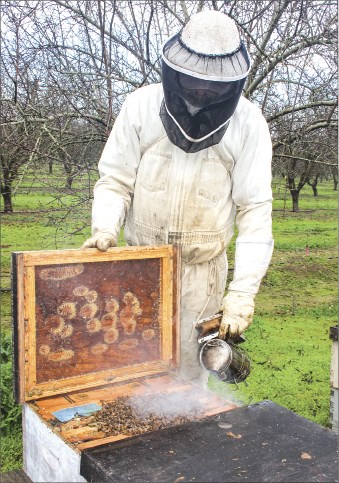
By Christine Souza
During the next few weeks, beekeepers will finish moving some 2.5 million honeybee colonies into California orchards to pollinate the state’s 1.2 million bearing acres of almond trees.
“We’re working really hard to supply a good supply of bees for the almond growers and doing everything that we can to keep up with their increase in production,” Butte County beekeeper Buzz Landon said.
As another 300,000 almond acres come into production in the next few years, beekeepers and farmers say an additional 600,000 beehives will be needed for pollination. Achieving that could be somewhat daunting, as beekeepers report annual bee losses due to challenges such as reduced forage, the Varroa mite and pesticide-related issues.
At the annual conference of the American Honey Producers Association and Canadian Honey Council, held recently in Sacramento, state Food and Agriculture Secretary Karen Ross said California border stations cleared 1.82 million beehives to enter the state in 2019.
Going into this season, Ross reminded beekeepers to register movement of beehives in and out of orchards to protect the apiaries from theft and from applications of crop protection materials. The state’s BeeCheck program requires beekeepers to register beehive locations with county agricultural commissioners. Last year, agricultural commissioners added BeeWhere, a software program to assist beekeepers in registering beehives.
Beekeeper Valeri Strachan-Severson of Yuba City said many out-of-state beekeepers oppose the registration program, but said, “It’s important. This has been on the books for 30 years.”
Daren Williams, senior director of communications for the Almond Board of California, said he expects almond production to grow from the current 2.3 billion pounds to the 3 billion-pound mark.
“For at least the next three to five years, most experts are projecting that this industry is going to continue to grow in acreage and in pounds. Of course, the pounds that we produce are very dependent upon pollination,” Williams said.
Last week, the Almond Board announced a new, five-point Pollinator Protection Plan aimed at protecting bees. The plan includes new collaboration with the nonprofit Pollinator Partnership; educating farmers and pollination stakeholders; improving communication; increasing on-farm floral diversity; and supporting bee health research.
At the honey producers conference, almond grower Ryan Cosyns of Madera, who used to manage honeybees, addressed pollination prices during a panel discussion.
“We need beekeepers that are pricing their product at a price that warrants what they had put into it,” Cosyns said. “The minimum price this year should be about $200 a hive. If you’re pricing under that, you’re doing yourself an injustice.”
In turn, beekeepers warned growers to watch out for “fly-by-night bee brokers,” who they said undercut the business with less than standard-quality bees.
Pollination services, Williams pointed out, represent “a significant input cost for growers, about 15 to 20% of a grower’s total production costs.”
Farmers have experimented with a self-fertile almond variety, Independence, which requires fewer bee colonies for pollination. Cosyns said the trees are only a fraction of the state’s total almond acres, and that planting of the variety has slowed because it does not have the same flavor as nonpareil, the top almond variety.
Many beekeepers at the conference had their minds on getting out and checking bees they had moved into bee yards or orchards.
Stanislaus County beekeeper Matt Beekman said he stored his apiaries in a bee yard in anticipation of bloom.
“For my growers, we’re doing some supplemental feeding in preparation for almond pollination, and we’re expecting to start moving bees either this week or the following week, depending upon the weather,” Beekman said.
A few miles away in Ballico, Merced County almond grower Eric Harcksen, who also brokers honeybees, said things are getting busy in the orchards.
“We have beekeepers from Indiana who are here in our almonds right now,” Harcksen said, adding, “We broker their bees; they bring them in from Indiana and then I put them into the almonds for them and take them out.”
During the honey conference, Iowa-based beekeeper Alex Ebert said he tripled the number of beehives he brought to California this year.
“After we get done with the conference, then we go take a look at how the bees are doing and get ready for almond pollination in February,” Ebert said.
Tulare County beekeeper Steve Godlin, who lost 100 beehives to theft last year at this time, said people in rural areas should be aware of the possibility of beehive thefts and suspicious activity.
“If you live near an almond orchard and see somebody loading bees onto a truck and out of the orchard, they are likely being stolen, so please call law enforcement,” Godlin said. “Get a license plate number or photo and report it.”
Hilmar Farm Watch, a rural-watch group working with law enforcement, reported 32 beehives allegedly stolen Jan. 7 from the Stevinson area of Merced County.


